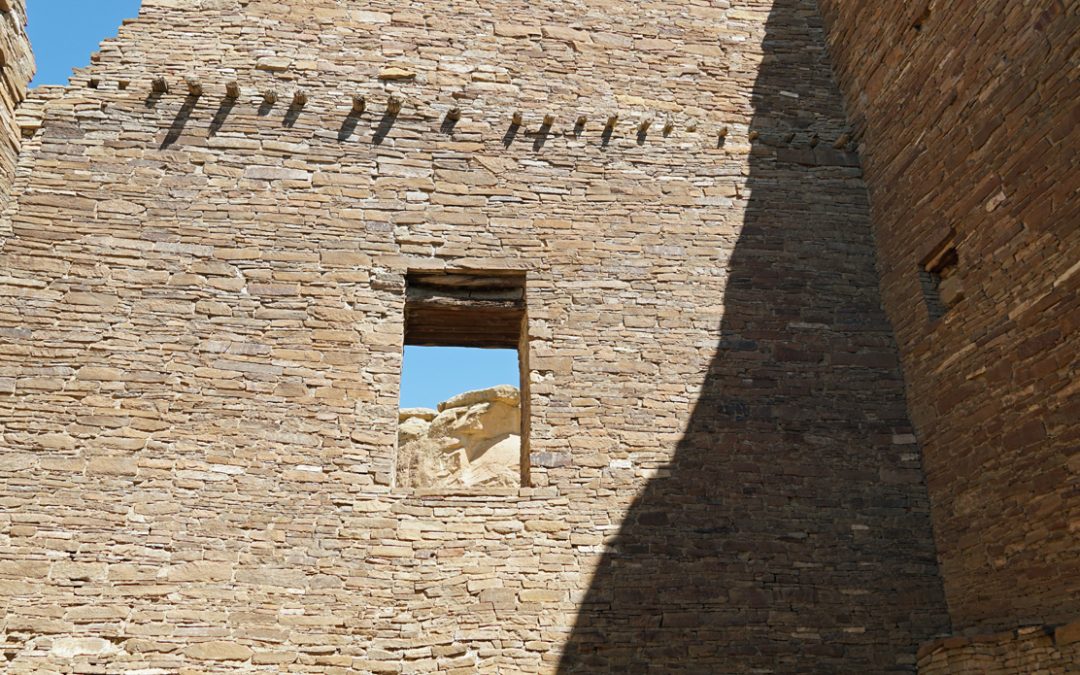
Steve Lekson briefing members at Chetro Ketl
Chaco Canyon and the so-called “Chaco Phenomenon” have long evoked intense interest among SAR members. Our more-or-less annual tradition of Chaco field trips continued in mid-August, when fourteen members and SAR staff spent three days visiting Chaco, Salmon Ruins, and Aztec Ruins National Monument in the company of archaeologist Stephen Lekson.
Lekson is a former curator of archaeology at the University of Colorado’s Museum of Natural History and the author of such noted works as The Chaco Meridian (2nd ed., 2015) and A History of the Ancient Southwest (2009)—the latter one of SAR Press’s all-time best-selling titles. His compulsively readable (and, for some archaeologists, controversial) books draw on his experience directing more than forty archaeological projects throughout the Southwest.

Restored Great Kiva, Aztec Ruins site
The unusually heavy monsoon rains of July and August put our access to Chaco in doubt, as portions of the road leading to the national monument had been washed out a few days before our trip. Fortunately, the experienced drivers of our two passenger vans were able to negotiate the damaged sections and bring us to the valley as planned. On the first day we visited Chetro Ketl and Kin Kletso as well as some smaller and less well known sites. Day Two focused on Pueblo Bonito as well as Pueblo del Arroyo. The third day of the field trip was spent at Salmon Ruins in Bloomfield and Aztec Ruins in nearby Aztec. The restored great kiva at Aztec was one of the high points of the trip.

SAR team working in Chacoan kiva, 1929
Steve Lekson framed his comments on these sites by reviewing the turbulent history of American archaeology and growing appreciation for Native American oral histories of Chaco. Interpretations of Chacoan sites have long mirrored the prejudices and obsessions of those who stumbled upon them, from the belief of Spanish, Mexican, and early Anglo visitors that complexes such as Pueblo Bonito were built by ancestors of the Aztecs to later theories that these elaborate structures functioned primarily as religious pilgrimage sites. As the scale of Chaco’s sites became better known to Americans, it also served as a focus for archaeologists seeking to make a name for themselves. Prominent among them was SAR’s founding president, Edgar Lee Hewitt.
Lekson contends that the Chaco Phenomenon was based on emerging social inequality most likely inspired by similar developments in northern and central Mexico. Without some element of social inequality and coercion, it is hard to comprehend the extraordinary labor inputs required to construct the buildings and network of roads completed by the early twelfth century and abandoned only decades later. This view is consistent with the view of contemporary Pueblo and Diné peoples that “bad things” happened in Chaco Canyon.
Efforts to understand these enigmatic sites will continue, as will the controversies surrounding them. It’s fair to say that our group was grateful for the opportunity to visit Chaco, Salmon, and Aztec in such expert company.
